General, Sir John Monash, Personal Files Book 21, 10 September - 3 October 1918 - Part 15
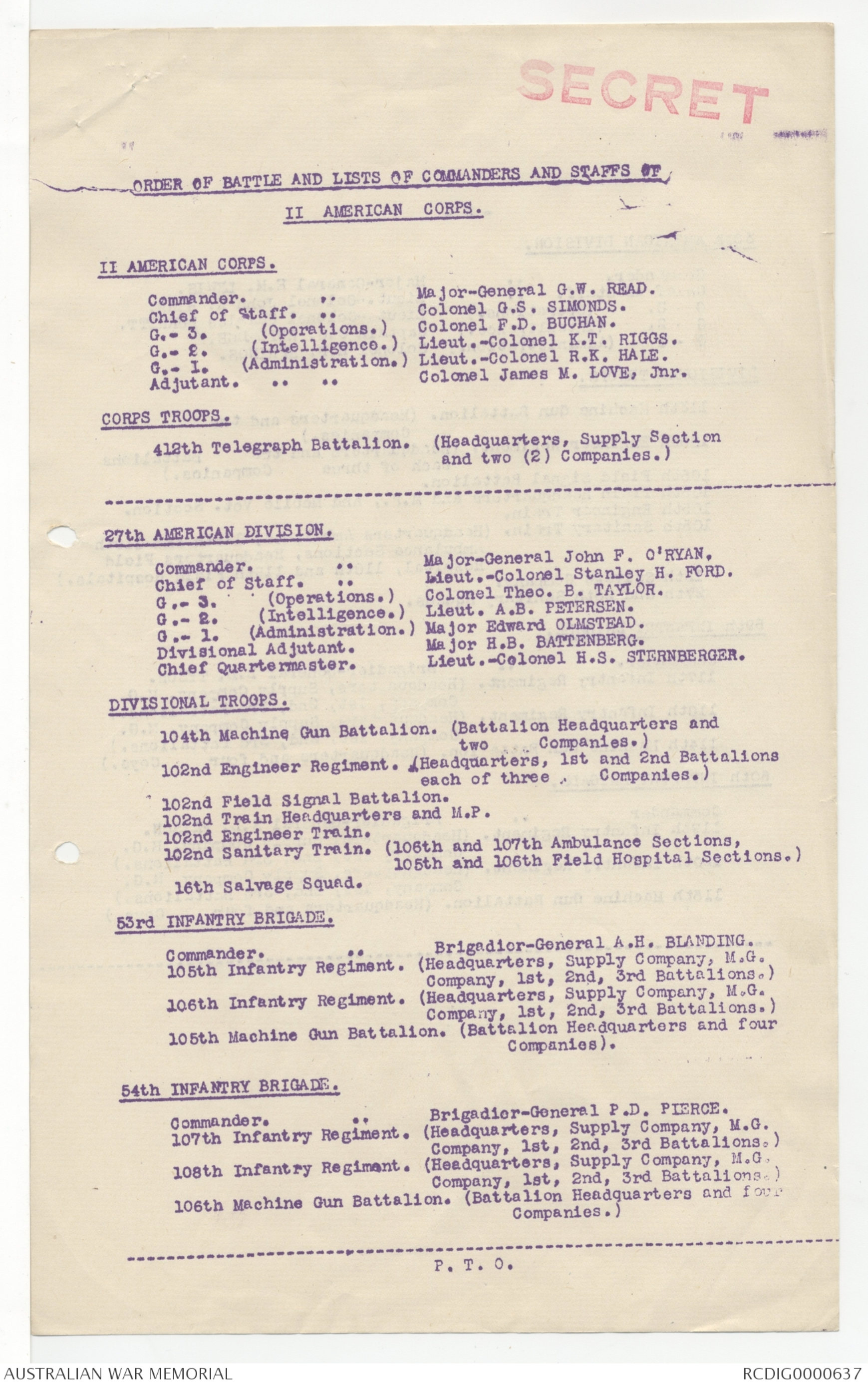
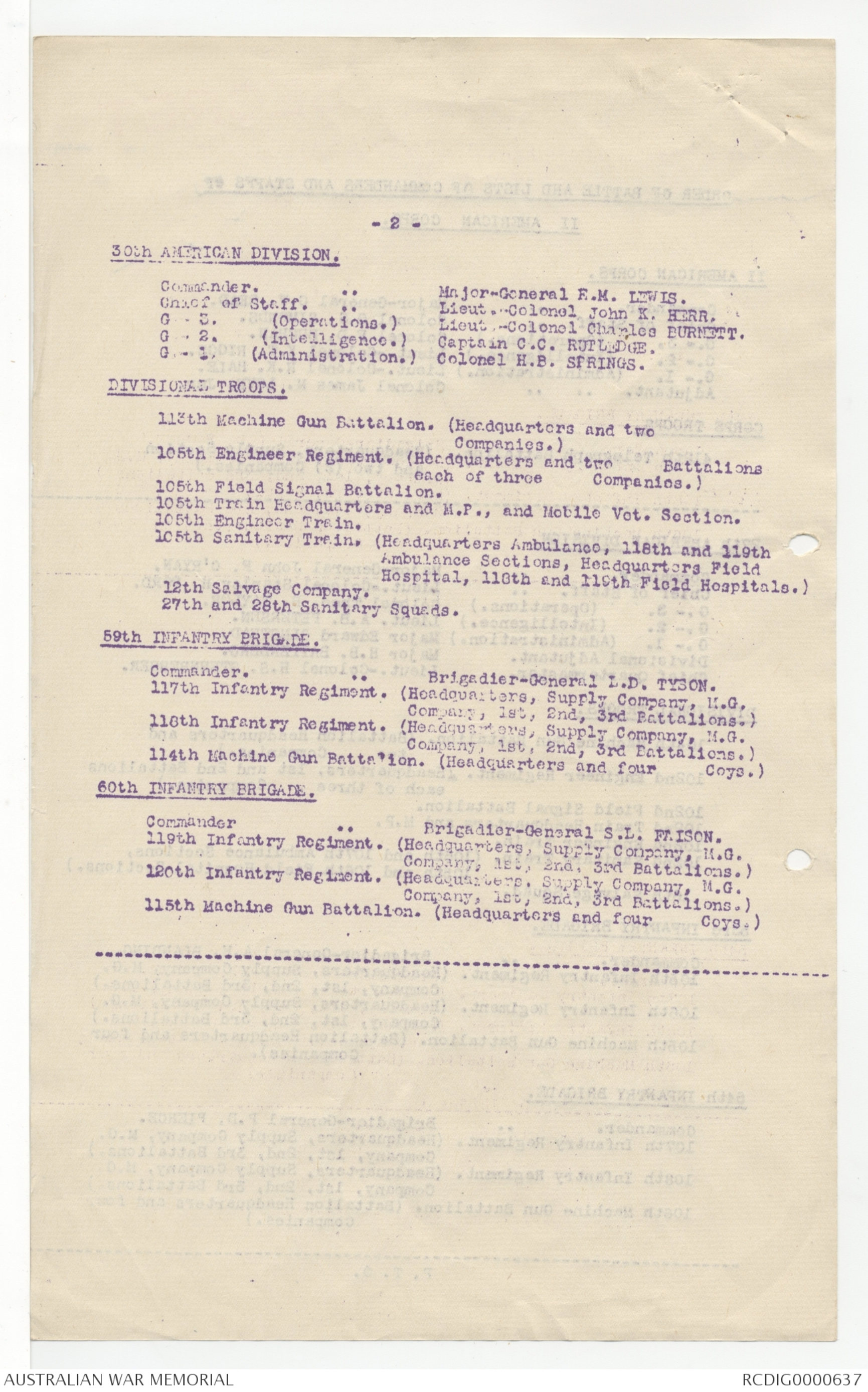
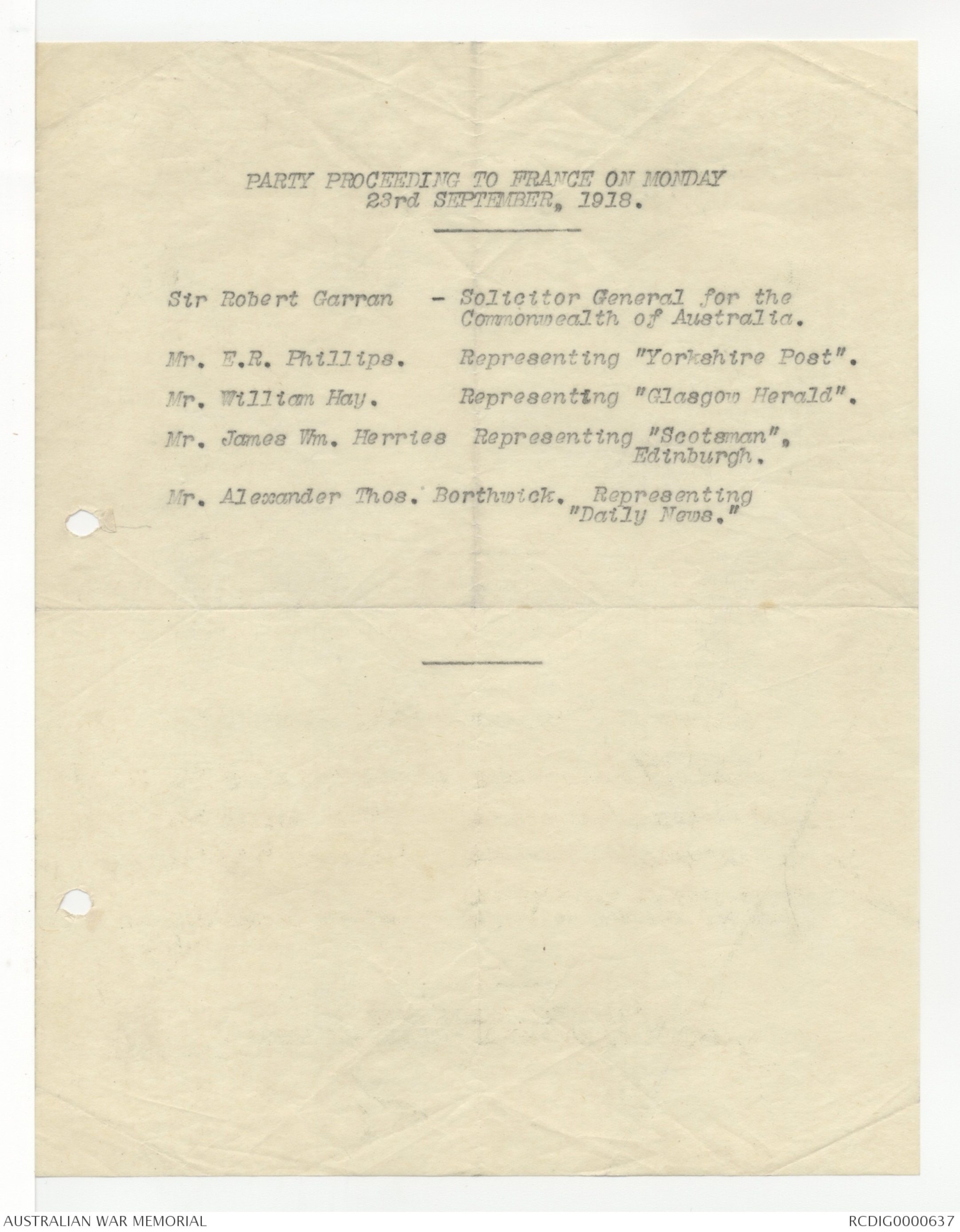
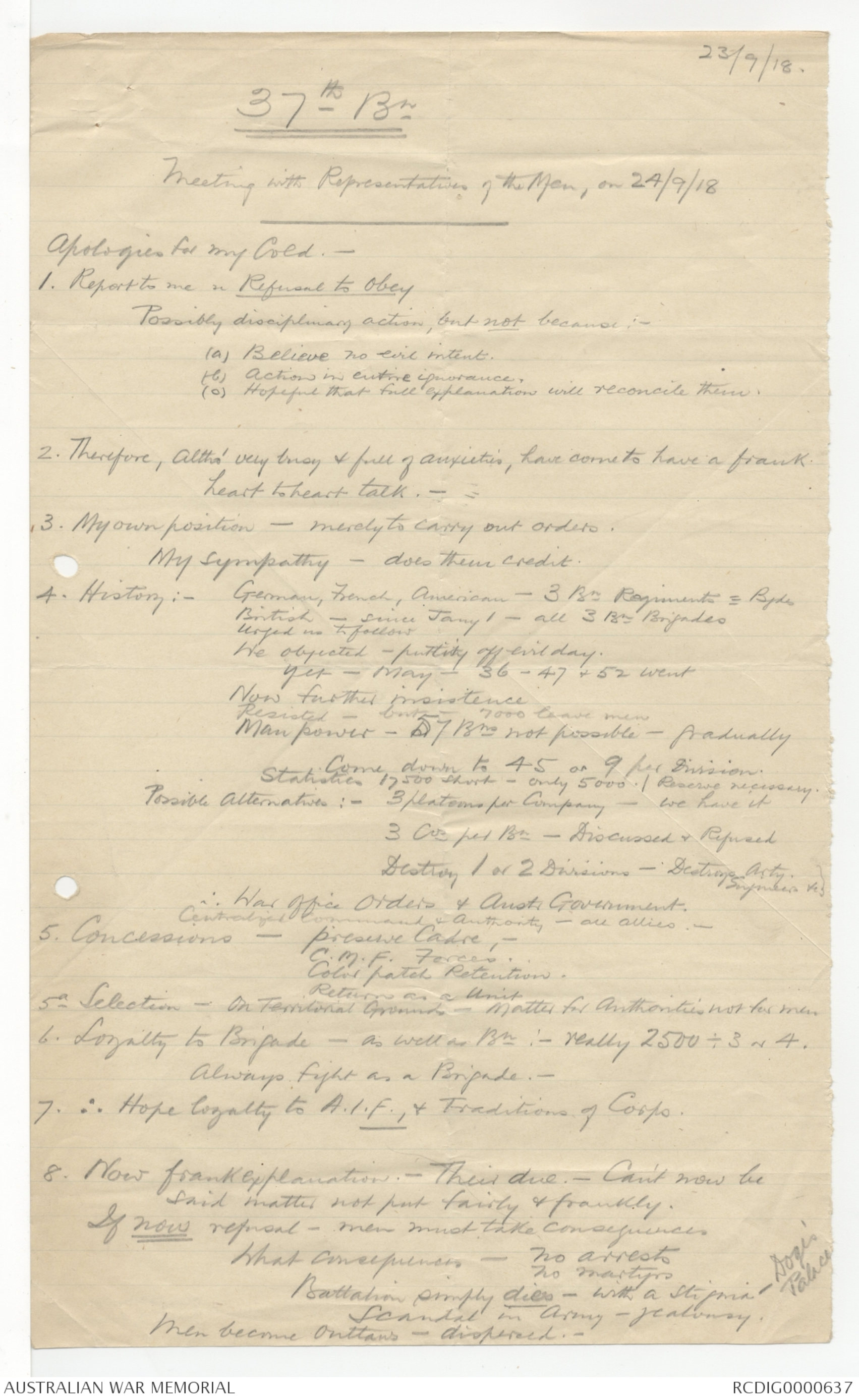
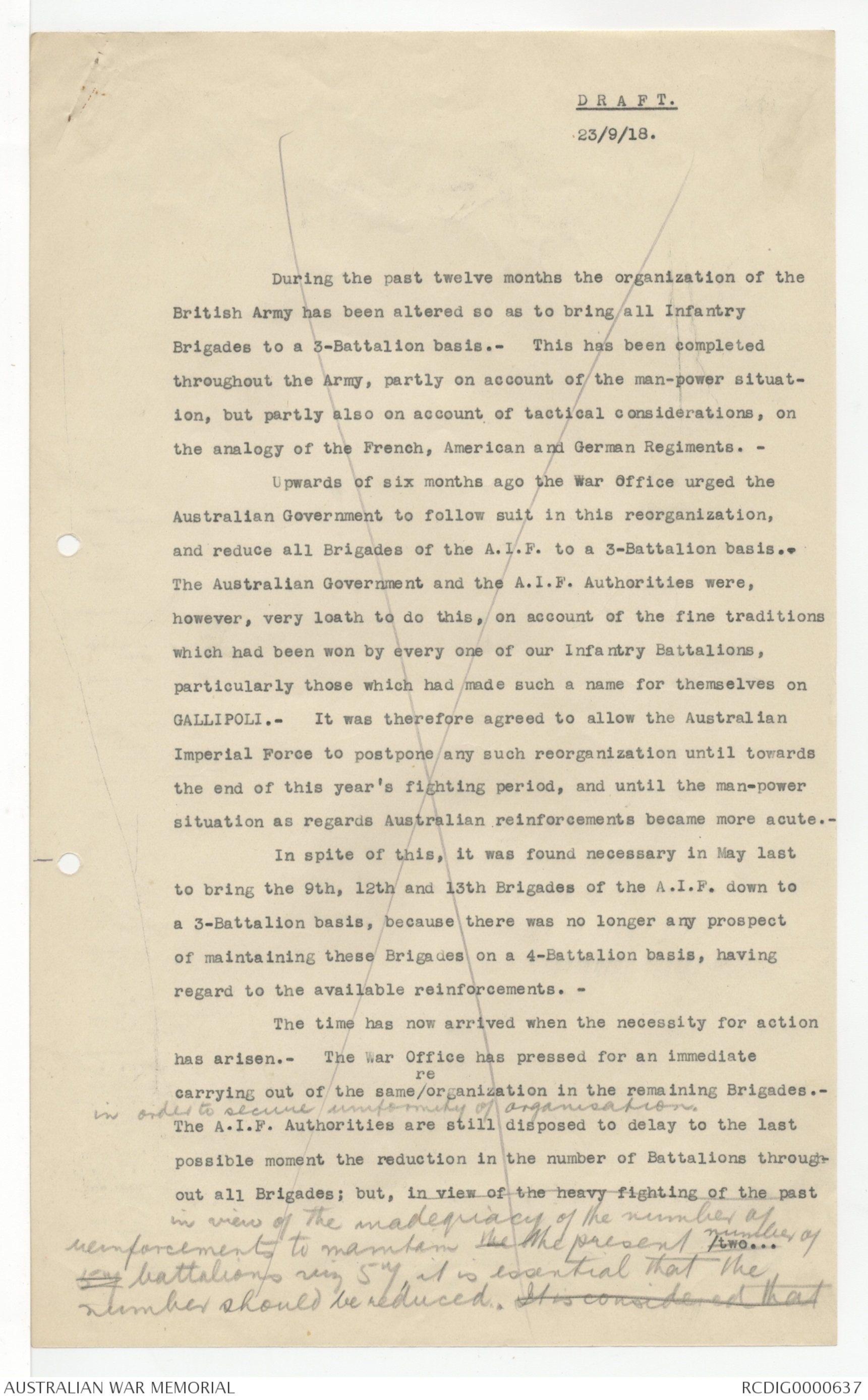
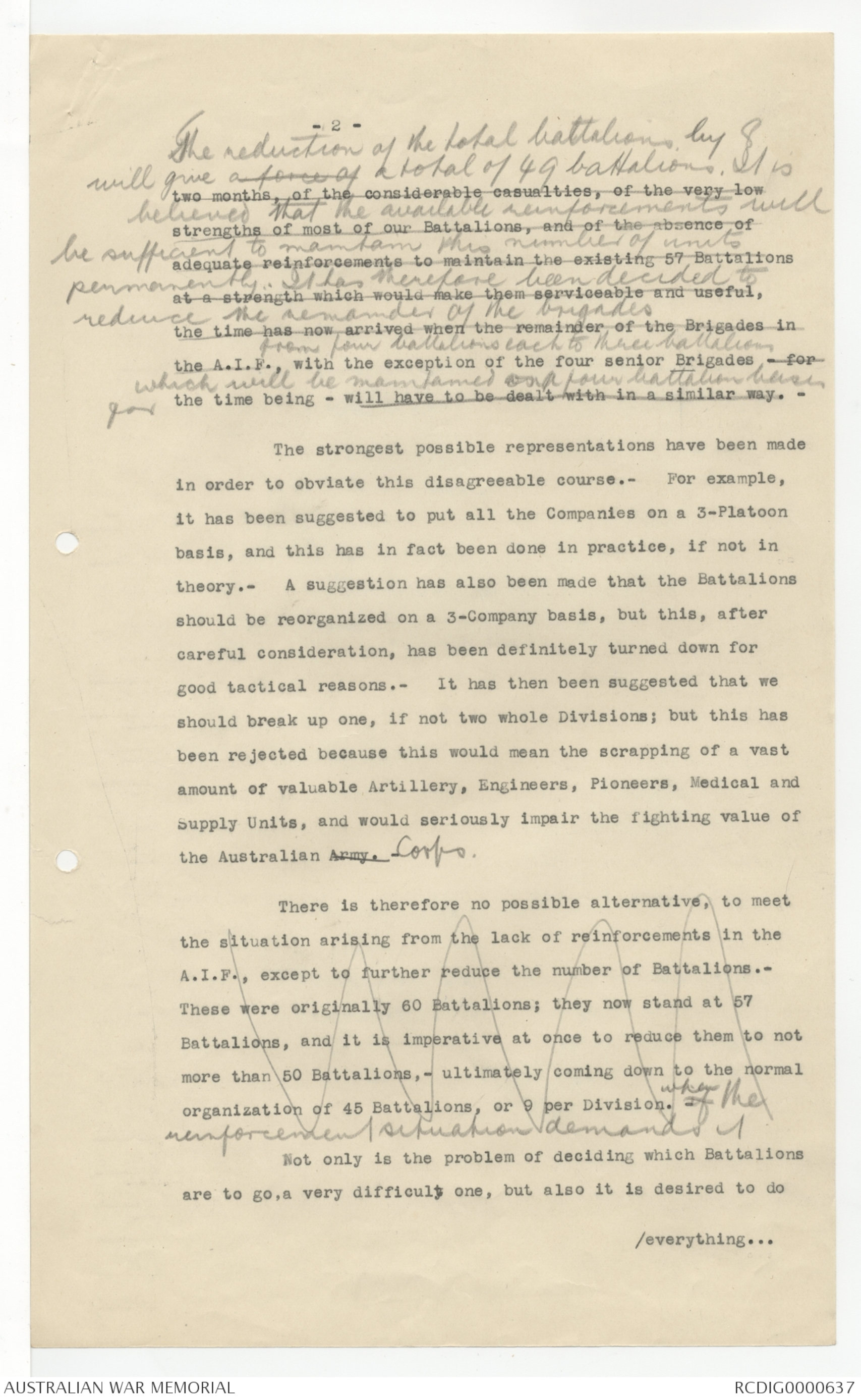
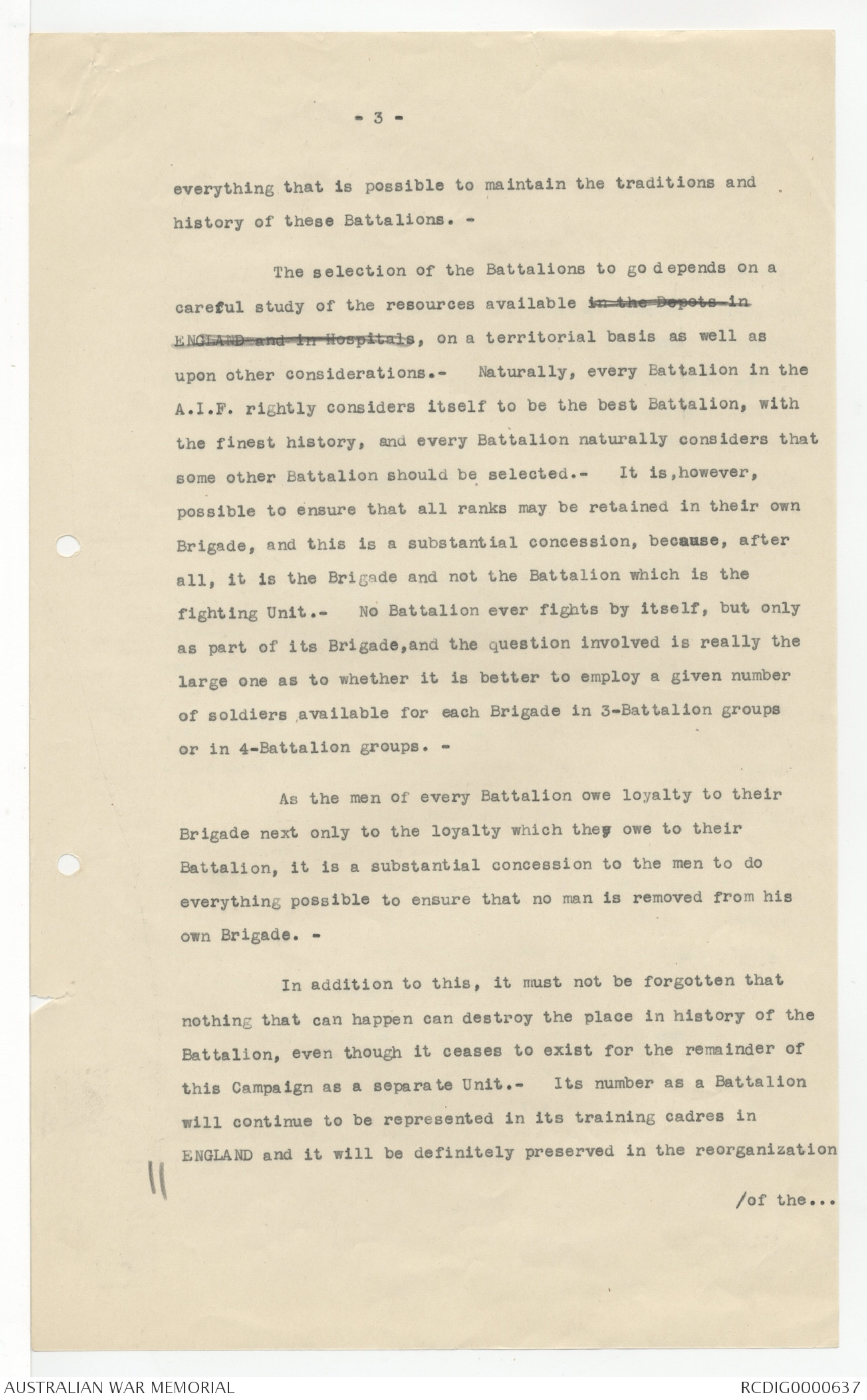
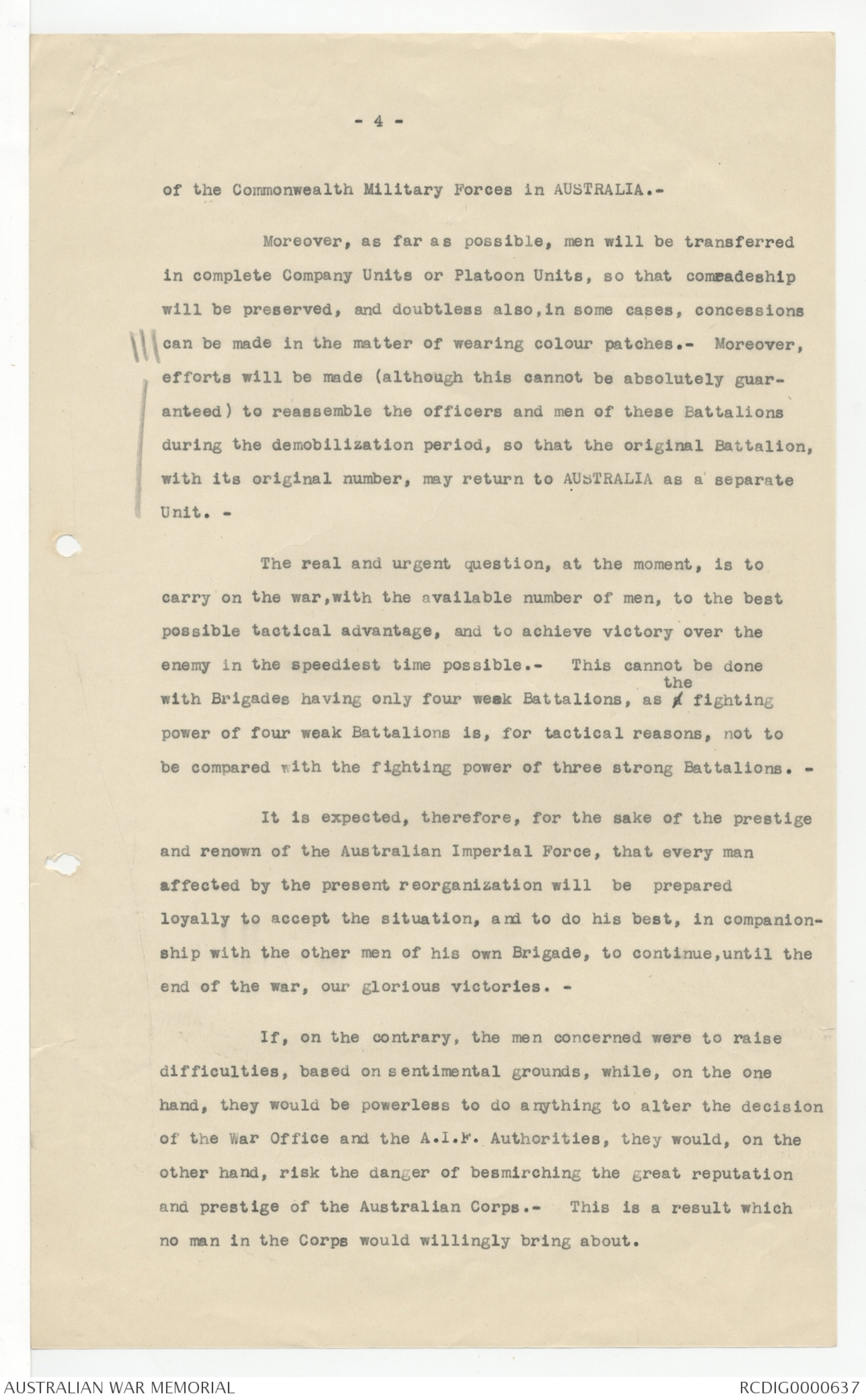
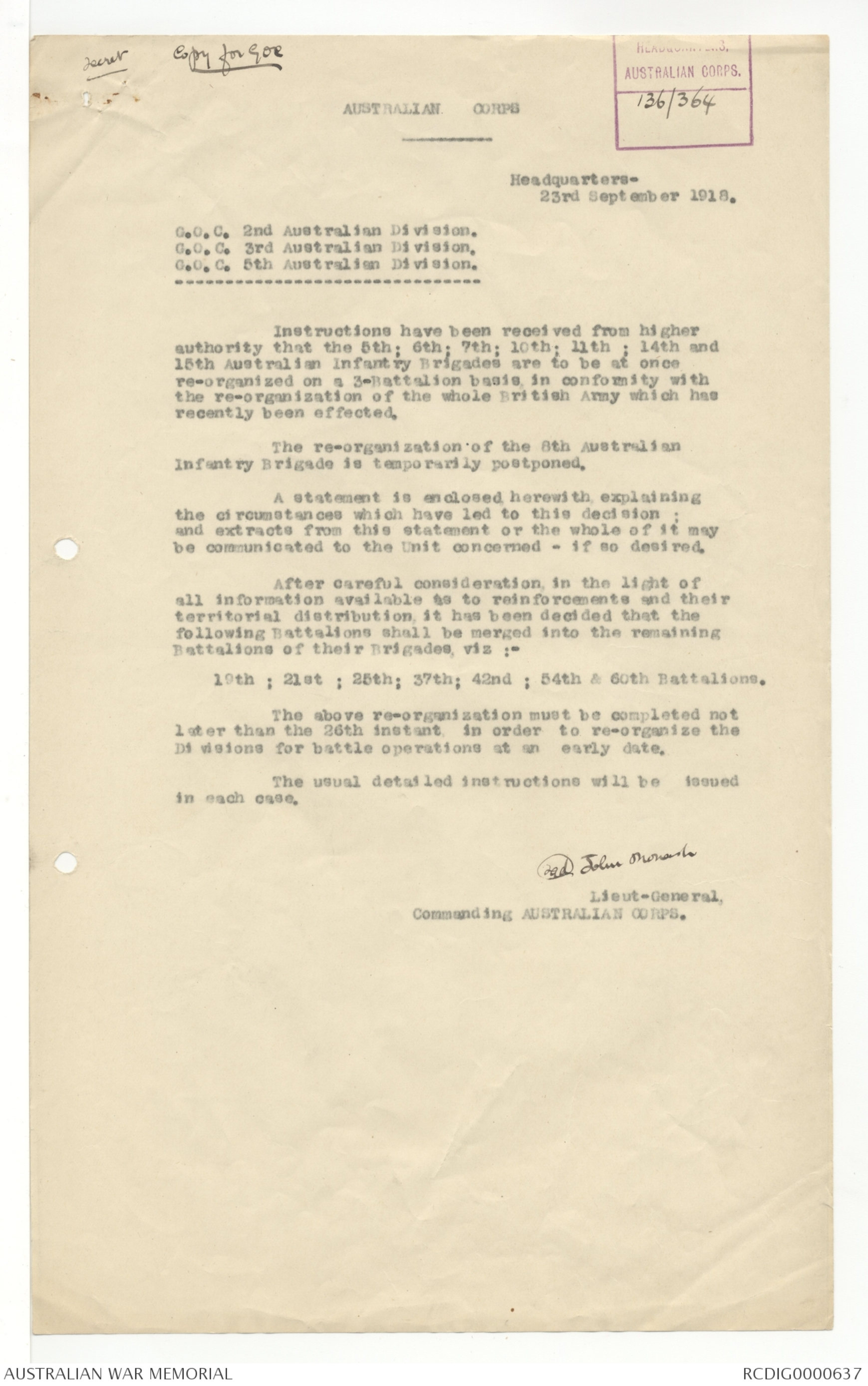
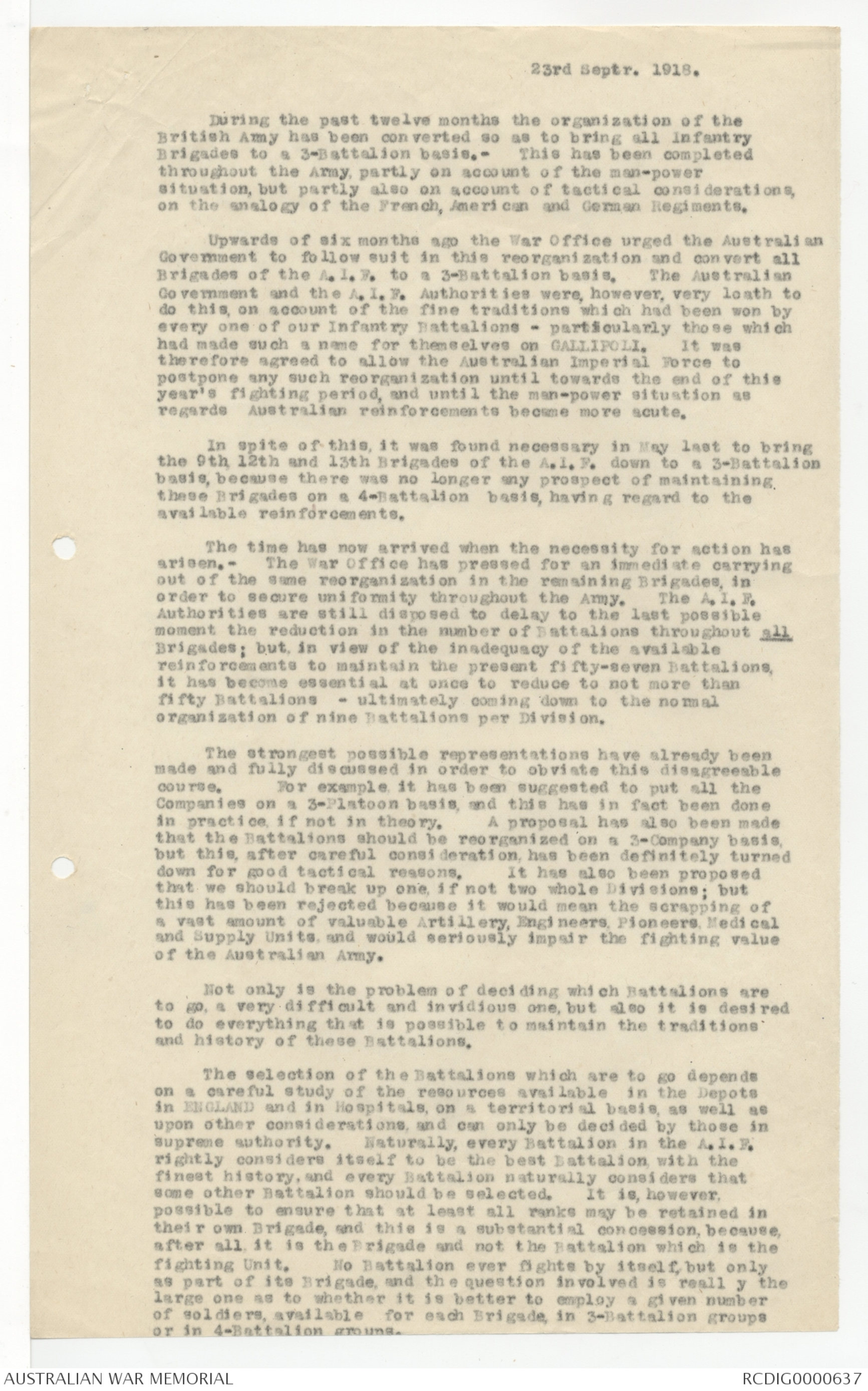
[*SECRET*]
ORDER OF BATTLE AND LITS OF COMMANDERS AND STAFFS OF
II AMERICAN CORPS.
| II AMERICAN CORPS. | |
| Commander. | Major-General G. W. READ. |
| Chief of Staff. | Colonel G. S. SIMONDS. |
| G.-3. (Operations.) | Colonel F. D. BUCHAN. |
| G.-2. (Intelligence.) | Lieut.-Colonel K. T. RIGGS. |
| G.-1. (Administration.) | Lieut.-Colonel R. K. HALE. |
| Adjutant. | Colonel James M. Love, Jnr. |
| CORPS TROOPS. | |
| 412th Telegraph Battalion. | (Headquarters, Supply Section and two (2) Companies.) |
| 27th AMERICAN DIVISION | |
| Commander. | Major-General John. F. O'Ryan. |
| Chief of Staff. | Lieut.-Colonel Stanley H. FORD. |
| G.-3. (Operations.) | Colonel Theo. B. TAYLOR. |
| G.-2. (Intelligence.) | Lieut. A. B. PETERSEN. |
| G.-1. (Administration.) | Major Edward OLMSTEAD. |
| Divisional Adjutant. | Major H. B. BATTENBERG |
| Chief Quartermaster. | Lieut. Colonel H. S. STERNBERGER |
| DIVISIONAL TROOPS. | |
| 104th Machine Gun Battalion. | (Battalion Headquarters and two Companies.) |
| 102nd Engineer Regiment. | Headquarters, 1st and 2nd Battalions each of three Companies |
| 102nd Field Signal Battalion. | |
| 102nd Train Headquarters and M.P. | |
| 102nd Engineer Train. | |
| 102nd Sanitary Train. | (106th and 107th Ambulance Sections, 105th and 106th Field Hospital Sections.) |
| 16th Salvage Squad. | |
| 53rd INFANTRY BRIGADE. | |
| Commander. | Brigadier-General A. H. BLANDING. |
| 105th Infantry Regiment. | (Headquarters, Supply Company, M.G. Company, 1st, 2nd, 3rd Battalions.) |
| 106th Infantry Regiment. | (Headquarters, Supply Company, M.G. Company, 1st, 2nd, 3rd Battalions.) |
| 105th Machine Gun Battalion | (Battalion Headquarters and four Companies). |
| 54th INFANTRY BRIGADE. | |
| Commander | Brigadier-General P. D. PIERCE. |
| 107th Infantry Regiment | (Headquarters, Supply Company. M.G. Company, 1st, 2nd, 3rd Battalions.) |
| 108th Infantry Regiment | (Headquarters, Supply Company. M.G. Company, 1st, 2nd, 3rd Battalions.) |
| 106th Machine Gun Battalion | (Battalion Headquarters and four Companies.) |
P.T.O
-2 -
| 3Oth AMERICAN DIVISION. | |
| Commander. | Major-General E. M. LEWIS. |
| Chief of Staff | Lieut.-Colonel John K. HERR. |
| G.-3. (Operations.) | Lieut.-Colonel Charles BURNETT. |
| G.-2. (Intelligence.) | Captain C. C. RUTLEDGE. |
| G.-1. (Administration.) | Colonel H. B. SPRINGS. |
| DIVISIONAL TROOPS. | |
| 113th Machine Gun Battalion. | (Headquarters and two Companies.) |
| 105th Engineer Regiment. | (Headquarters and two Battalions each of three Companies.) |
| 105th Field Signal Battalion. | |
| 105th Train Headquarters and M.P., and Mobile Vet. Section | |
| 105th Engineer Train | |
| 105th Sanitary Train. | (Headquarters Ambulance, 118th and 119th Ambulance Sections, Headquarters Field Hospital, 118th and 119th Field Hospitals.) |
| 12th Salvage Company. | |
| 27th and 28th Sanitary Squads. | |
| 59th INFANTRY BRIGADE. | |
| Commander. | Brigadier-General L. D. TYSON. |
| 117th Infantry Regiment. | (Headquarters, Supply Company. M.G. Company, 1st, 2nd, 3rd Battalions.) |
| 116th Infantry Regiment. | (Headquarters, Supply Company, M.G. Company, 1st, 2nd, 3rd Battalions.) |
| 114th Machine Gun Battalion. | (Headquarters and four Coys.) |
| 60th INFANTRY BRIGADE. | |
| Commander | Brigadier-General S. L. FAISON. |
| 119th Infantry Regiment. | (Headquarters, Supply Company, M.G. Company, 1st, 2nd, 3rd Battalions.) |
| 120th Infantry Regiment | (Headquarters, Supply Company, M.G. Company, 1st, 2nd, 3rd Battalions.) |
| 115th Infantry Regiment | (Headquarters and four Coys.) |
PARTY PROCEED ING TO FRANCE ON MONDAY
23rd SEPTEMBER, 1918.
Sir Robert Garran - Solicitor General for the
Commonwealth of Australia.
Mr. E. R. Phillips. Representing "Yorkshire Post".
Mr. William Hay. Representing "Glasgow Herald".
Mr. James Wm. Herries Representing "Scotsmen".
Edinburgh.
Mr. Alexander Thos. Borthwick. Representing
"Daily News."
23/9/18.
37th Bn
Meeting with Representatives of the Men, on 24/9/18
Apologies for my Cold. –
1. Report to me n Refusal to obey
Possibly disciplinary action, but not because: -
(a) Believe no evil intent.
(b) Action in entire ignorance.
(c) Hopeful that full explanation will reconcile them.
2. Therefore, Alth'o very bury & full of anxieties, have come to have a frank
heart to heart talk.
3. My own position - merely to carry out orders.
My sympathy - does them credit.
4. History: - German, French, American 0 3 Bn Regiments
British - since Jany 1 - all 3 Bn Brigades
urged us to follow
We objected - putting off evil day.
Yet - May - 36 - 47 & 52 went
Now further insistence
Resisted - brit - 7000 leave men
Manpower - D57 Bns not possible - gradually
Come down to 45 or 9 per Division
Statistics 17500short - only 5000. / Reserve necessary
Possible Alternatives: - 3 platoon per Company – we have it
3 Cos per Bnb - Discussed & Refused
Destroy 1 or 2 Divisions - Destroys Arty. )
Engineers &c)
∴ War Office Orders & Austr Government.
Centralized Command & Authority – all Allies. -
5. Concessions — preserve Cadre, -
C.M.F. Forces.
Color patch Retention.
Return as a Unit
5a Selection – On Territorial Groups – Matter for Authorities not for men
6. Loyalty to Brigade – as well as Bn: - really 2500 ÷ 3 or 4.
Always fight as a Brigade. -
7. ∴ Hope loyalty to A.I.F., & Traditions of Corps.
8. Now frank explanation. - Their due. - Can't now be
said matter not put fairly & frankly.
If now refusal - men must take consequences
What consequences – no arrests
no martyrs
Battalion simply dies - with a stigma [*- Doge's
Police*]
Scandal in Army - jealousy.
Men become Onttan's - dispersed. -
DRAFT.
23/9/18.
During the past twelve months the organization of the
British Army has been altered so as to bring all Infantry
Brigades to a 3-Battalion basis.- This has been completed
throughout the Army, partly on account of the man-power situation,
but partly also on account of tactical considerations, on
the analogy of the French, American and German Regiments. -
Upwards of six months ago the War office urged the
Australian Government to follow suit in this reorganization,
and reduce all Brigades of the A.J.F. to a 3-Battalion basis..
The Australian Government and the A.I.F. Authorities were,
however, very loath to do this, on account of the fine traditions
which had been won by every one of our Infantry Battalions,
particularly those which had made such a name for themselves on
GALLIPOLI.- It was therefore agreed to allow the Australian
Imperial Force to postpone any such reorganization until towards
the end of this year's fighting period, and until the man-power
situation as regards Australian reinforcements became more acute. -
In spite of this, it was found necessary in May last
to bring the 9th, 12th and 13th Brigades of the A.I.F. down to
a 3-Battalion basis, because there was no longer any prospect
of maintaining these Brigades on a 4-Battalion basis, having
regard to the available reinforcements. -
The time has now arrived when the necessity for action
has arisen.- The War Office has pressed for an immediate
carrying out of the same organization in the remaining Brigades.
in order to secure uniformity of organisation.
The A.I.F. Authorities are still disposed to delay to the last
possible moment the reduction in the number of Battalions througout
all Brigades; but, in view of the heavy fighting of the past
in view of the inadequacy of the number of
reinforcements to maintain the the present /two . . . number of 57 Battalions viz 57, it is essential that the
number should be reduced. It is considered that
-2-
The reduction of the total battalions by 8
will give a force of a total of 49 battalions. It istwo months of considerable casualties, of the very low
believed that the available reinforcements willstrengths of most of our Battalions, and of the absence of
be sufficient to maintain this number of unitsadequate reinforcements to maintain the existing 57 Battalions
permanently. It has therefore been decided toat a strength which would make them serviceable and useful,
reduce the remainder of the Brigadesthe time has now arrived when the remainder of the Brigades in
from four battalions each to three battalionsthe A.I.F., with the exception of the four senior Brigades,- for
which will be maintained on a four battalion basis
for the time being - will have to be dealt with in a similar way. -
The strongest possible representations have been made
in order to obviate this disagreeable course.- For example,
it has been suggested to put all the Companies on a 3-Platoon
basis, and this has in fact been done in practice, if not in
theory.- A suggestion has also been made that the Battalions
should be reorganized on a 3-Company basis, but this, after
careful consideration, has been definitely turned down for
good tactical reasons.- It has then been suggested that we
should break up one, if not two whole Divisions; but this has
been rejected because this would mean the scrapping of a vast
amount of valuable Artillery, Engineers, Pioneers, Medical and
Supply Units, and would seriously impair the fighting value of
the Australian Army. Corps.There is therefore no possible alternative, to meetthe situation arising from the lack of reinforcements in theA.I.F., except to further reduce the number of Battalions.-These were originally 60 battalions; they now stand at 57Battalions, and it in imperative at once to reduce them to notmore than 50 Battalions,- ultimately coming down to the normalorganization of 45 Battalions, or 9 per Division. if when thereinforcement situation demanded it
Not only is the problem of deciding which Battalions
are to go,a very difficult one, but also it is desired to do
/everything...
-3 -
everything that is possible to maintain the traditions and
history of these Battalions.-
The selection of the Battalions to go depends on a
careful study of the resources available in the depots inENGLAND and in Hospitals, on a territorial basis as well as
upon other considerations.- Naturally, every Battalion in the
A.I.F. rightly considers itself to be the best Battalion, with
the finest history, and every Battalion naturally considers that
some other Battalion should be selected.- It is,however,
possible to ensure that all ranks may be retained in their own
Brigade, and this is a substantial concession, becuaause, after
all, it is the Brigade and not the Battalion which is the
fighting Unit.- No Battalion ever fights by itself, but only
as part of its Brigade,and the question involved is really the
large one as to whether it is better to employ a given number
of soldiers available for each Brigade in 3-Battalion groups
or in 4-Battalion groups. -
As the men of every Battalion owe loyalty to their
Brigade next only to the loyalty which theey owe to their
Battalion, it is a substantial concession to the men to do
everything possible to ensure that no man is removed from his
own Brigade. -
In addition to this, it must not be forgotten that
nothing that can happen can destroy the place in history of the
Battalion, even though it ceases to exist for the remainder of
this Campaign as a separate Unit.- Its number as a Battalion
will continue to be represented in its training cadres in
ENGLAND and it will be definitely preserved in the reorganization
[*||*]
/of the...
- 4 -
of the Commonwealth Military Forces in AUSTRALIA.-
Moreover, as far as possible, men will be transferred
in complete Company Units or Platoon Units, so that comadeship
will be preserved, and doubtless also, in some cases, concessions
[*|||*] can be made in the matter of wearing colour patches.- Moreover,
efforts will be made (although this cannot be absolutely guaranteed)
to reassemble the officers and men of these Battalions
during the demobilization period, so that the original Battalion,
with its original number, may return to AUSTRALIA as a separate
Unit.
The real and urgent question, at the moment, is to
carry on the war,with the available number of men, to the best
possible tactical advantage, and to achieve victory over the
enemy in the speediest time possible.- This cannot be done
with Brigades having only four weeak Battalions, as a the fighting
power of four weak Battalions is, for tactical reasons, not to
be compared with the fighting power of three strong Battalions. -
It is expected, therefore, for the sake of the prestige
and renown of the Australian Imperial Force, that every man
affected by the present reorganization will be prepared
loyally to accept the situation, and to do his best, in companionship
with the other men of his own Brigade, to continue,until the
end of the war, our glorious victories.
If, on the contrary, the men concerned were to raise
difficulties, based on sentimental grounds, while, on the one
hand, they would be powerless to do anything to alter the decision
of the War Office and the A.I.F. Authorities, they would, on the
other hand, risk the danger of besmirching the great reputation
and prestige of the Australian Corps.- This is a result which
no man in the Corps would willingly bring about.
[*Secret Copy for GOC*]
[*HEADQUARTERS.
AUTRALIAN CORPS..
136/364*}
AUSTRALIAN CORPS.
1361364
AUSTRALIAN
Headquarters-
23rd September 1918.
G.O.C. 2nd Australian Divieion.
G.O.C. 3rd Australian Divieson,
G.O.C. 5th Australian Divieson.
Instructions have been received from higher
authority the 5th; 6th; 7th; 10th; 11th; 14th and
15th Australian Infantry Brigades are to be at once
re-organized on a 3-Bettalion basis in conformity with
the re-organization of the whole British Army which has
recently been effected.
The re-organization of the 8th Australian
Infantry Brigade is temporarily postponed.
A statement is enclosed herewith explaining
the circumstances which have led to this decision
and extracts from this statement or the whole of it may
be communicated to the Unit concerned - if so desired.
After careful consideration in the light of
all information available tas to reinforcements and their
territorial distribution it has been decided that the
following Battalions shall be merged into the remaining
Battalions of their Brigades, vis :
19th ; 2lst ; 25th ; 37th ; 42nd; 54th ; & 60th Battalions.
The above re-organization must be completed not
later than the 26th instant in order to re-organise the
Di visions for battle operations at an early date.
The usual detailed instructions will be issued
in each case.
sgd. John Monash
Lieut-General,
Commending AUSTRALIAN CORPS.
23rd Septr. 1918.
During the past twelve months the organisation of the
British Army has been converted so as to bring all infantry
Brigades to a 3-Battalion basis.- Thie has been completed
throughout the Army partly on account of the man-power
situation but partly also on account of tactical considerations,
on the analogy of the French, American and Germen Regiments.
Upwards of six months ago the War Office urged the Australian
Government to follow suit in this reorganization and convert all
Brigades of the A.I.F. to a 3-Battelion basis. The Australian
Government and the A.I.F. Authorities were, however, very loath to
do this on account of the fine traditions which had been won by
every one of our Intantry Battalions - particularly those which
had made such a name for themselves on GALLIPOLI. It was
therefore agreed to allow the Australian Imperial Force to
postpone any such reorganization until towards the end of this
year's fighting period and until the men-power situation as
regards Australian reinforcements become more acute.
In spite of this it was found necessary in May last to bring
the 9th, 12th and 13th Brigades of the A.I.F. down to a 3-Battalion
basis because there was no longer any prospect of maintaining
these Brigades on a 4-Battalion basis having regard to the
available reinforcements.
The time has now arrived when the necessity for action has
arisen.- The War Office has pressed for an immediate carrying
out of the some reorganization in the remaining Brigades, in
order to secure uniformity throughout the Army. The A.I.F.
Authorities are still disposed to delay to the last possible
moment the reduction in the number of Battalions throughout
Brigades; but. is view of the inadequacy of the available
reinforcements to maintain the precent fifty-seven Battalions
it has become essential at once to reduce to not more than
fifty Battalions - ultimately coming down to the normal
organization of nine Battalions per Division.
The strongest possible representations have already been
made and fully discussed in order to obviate this disagreeable
course. For example it has ben suggested to put all the
Companies on a 3-Platoon basis and this has in fact been done
in practice if not in theory. A proposal has also been made
that the Battalion should be reorganized on a 3-Company basis
but this after careful consideration has been definitely turned
down for good tactical reasons. It has alco been proposed
that we could break up one if not two whole Divisions; but
this has been rejected because it would mean the scrapping of
a vast amount of valuable Artillery, Engineers, Pioneers; Medical
and Supply Units, and would seriously impair the fighting value
of the Australian Army.
Not only is the problem of deciding which Battalions are
to go a very difficult and invidious one, but also it is desired
to do everything that is possible to maintain the traditions
and history of these Battalions,
The selection of the Battalions which are to go depends
on a careful study of the resources available in the Depots
in ENGLAND and in Hospitals, on a territorial basis as well as
upon other considerations and can only be decided by those in
supreme authority. Naturally every Battalion in the A.I.F.
rightly considerers itself to be the best battalion with the
finest history, and every Battalion naturally considerers that
some other Battalion should be selected. it is however.
possible to ensure that at least all ranks may be retained in
their own Brigade and this is a substantial concession, because
after all it is the Brigade and not the Battalion which is the
fighting Unit. No Battalion ever fights by itself, but only
as part of its Brigade and the question involved e reall y the
large one as to whether it is better to employ a given number
of soldiers available for each Brigade in 3-Battalion groups
or in 4-Battalion groups.
 Sam scott
Sam scottThis transcription item is now locked to you for editing. To release the lock either Save your changes or Cancel.
This lock will be automatically released after 60 minutes of inactivity.